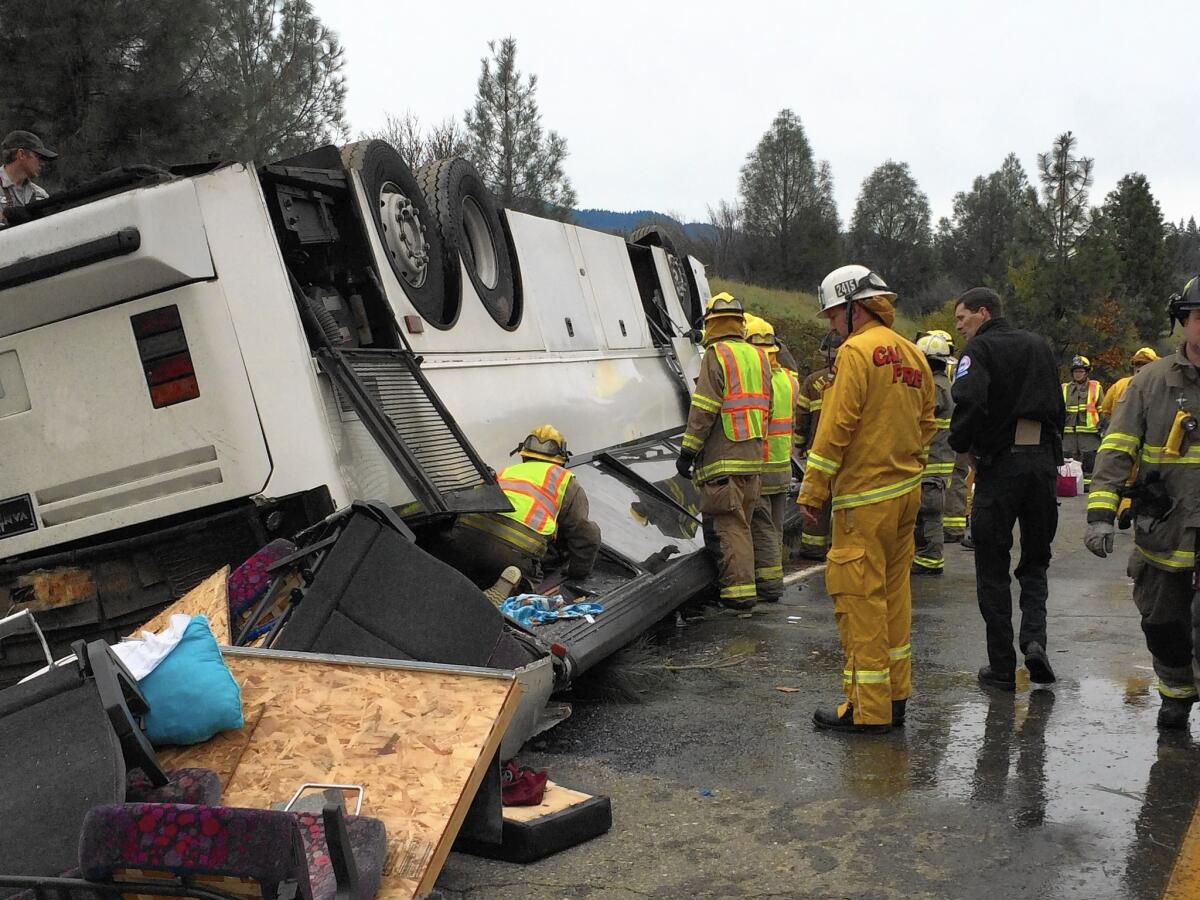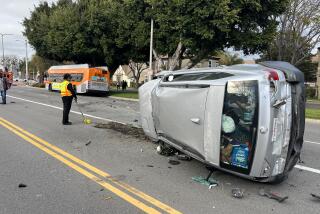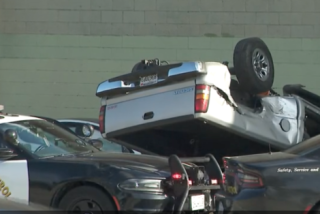CHP looks at whether driver fatigue was a factor in fatal bus crash

Authorities are looking into how many hours a tour bus driver had been behind the wheel Sunday when he crashed twice in Northern California, with the second accident killing one man and injuring 30 other passengers.
The California Highway Patrol said Monday the fact that the bus crashed into a Denny’s before the deadly crash hours later suggests that the driver, Jose Victor Garcilazo Palencia, 67, of Los Angeles could have been fatigued.
But Officer Kim Baldi, of CHP’s Mount Shasta station, said that no conclusion had been made and that investigators are looking at other possible causes for the crash.
The 1996 Van Hool bus’ first crash occurred at 5:31 a.m. Sunday as it traveled from Los Angeles to Pasco, Wash., said Cpl. Josiah Ferrin of the Red Bluff Police Department. The bus, owned by Yellow Arrow Lines, was driving past the Denny’s restaurant and making a turn, possibly to park, when it apparently hit the eave of the restaurant’s roof, Ferrin said.
Palencia told authorities that he was trying to avoid hitting a couple of yellow concrete barricades but that while his attention was diverted he maneuvered through the parking lot and did not realize how close he was to the roof. Damage to the building and bus was minor, Ferrin said.
“It was on private property, so there was no citation,” Ferrin said. Palencia “was contacted and appeared fine physically and didn’t seem impaired in any way.”
No one was injured in the first crash, authorities said.
But about two hours later, the bus drifted off the right shoulder of northbound Interstate 5, in an area north of Pollard Flat, about 100 miles south of Oregon, the CHP said. The bus went down an embankment and overturned before coming to rest on its roof on a frontage road east of the freeway.
Octaviano Garcia, 33, of Parlier, Calif., died in the crash, according to the Shasta County coroner’s office. A coroner’s spokeswoman said an autopsy is planned for later this week. Dozens of passengers were also injured and transported to local hospitals for treatment.
At Mercy Medical Center Redding, four patients were being treated Monday afternoon, a spokeswoman said. Two were upgraded from critical to serious condition, and two others were listed in fair condition. At Mercy Medical Center in Mount Shasta, the hospital had one patient in critical but stable condition, the spokeswoman said.
The National Transportation Safety Board was gathering information about the crash Monday, but “it doesn’t appear that we’re going to launch an investigation into this accident,” spokesman Terry Williams said.
A man who identified himself as Palencia’s son told The Times on Sunday that he had not heard from his father. He did not respond to phone calls Monday.
Federal records show that Yellow Arrow Lines has a fleet of six vehicles and 10 drivers. Duane DeBruyne, a spokesman for the federal agency, said the Othello, Wash., company passed a safety audit conducted in September 2013. A separate compliance review — which federal law would have required by March 2015 — “is being conducted immediately,” he said and will be provided to authorities to paint “as full a picture as possible of all the elements that may or may not have been at play in this crash.”
The company has been randomly inspected at least twice since it was formed and has had no accidents, the records show. But one of two drivers inspected was taken “out of service.” DeBruyne said a driver can be forced to stop operating if an inspector discovers problems with his or her credentials, medical certificates or log books — which record how long a driver has been on duty.
It was unclear why one of the company’s drivers was taken out of service.
DeBruyne declined to comment on the issue of driver fatigue but said federal law allows bus drivers to spend as many as 10 hours behind the wheel and as many as 15 hours on duty. But a driver must spend eight hours off-duty, he said. Specific information about Palencia is not available because of federal privacy laws, he said.
A man who answered the phone at Yellow Arrow Lines on Sunday declined to comment, and calls on Monday went unanswered.
Steve Keppler, executive director of the Commercial Vehicle Safety Alliance, said driver fatigue is a “big issue” both in the truck and bus driving industries.
Just because a driver is off-duty for eight hours does not mean the driver is resting that entire time, Keppler said. Problems such as a shortage of drivers and the rapid increase in “low-budget operators” have combined to reduce overall safety and increase crash rates in recent years, he said.
Safety on buses “ought to be a big priority for us,” Keppler said. “Buses are hauling our most precious cargo — people.”
And although CHP officials said driver fatigue was just one factor they were examining, authorities on Monday stressed the dangers of driving while very tired.
“Most people are aware of the dangers of drinking and driving,” the CHP said in a statement, “but don’t realize that driving while fatigued can be just as fatal as driving under the influence.”
Times staff writer Jeff Gottlieb contributed to this report.
More to Read
Start your day right
Sign up for Essential California for news, features and recommendations from the L.A. Times and beyond in your inbox six days a week.
You may occasionally receive promotional content from the Los Angeles Times.







